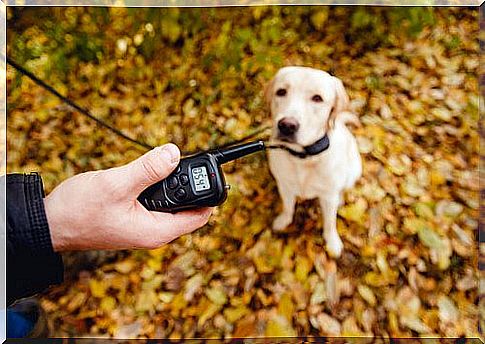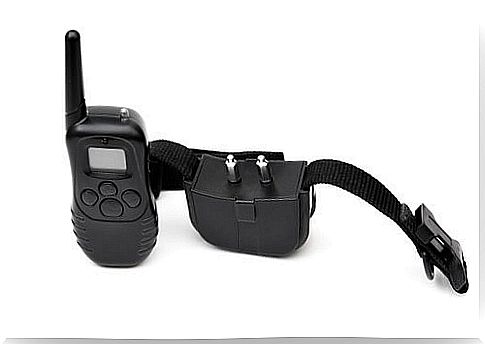Is The Anti-bark Collar Recommended?

One of the most uncomfortable habits our dogs have for us is barking. If a dog does this very often, then some people try the Bark Control Collar. We want to explain to you what it is and how it works.
What is a bark control collar?
A bark control collar is a device that activates when it detects activity in our dog’s throat. The device then sends a stimulus that is unpleasant for the dog so that it suppresses its barking.
Mostly it’s electric shocks, but it can also be ultrasound, vibration, or a spray.
The Bark Control Collar wants to punish our dog so that it stops barking. It wants the dog to associate its activity in the throat with something unpleasant. To avoid this stimulus, he supposedly stops barking.
This is the theory on which the Bark Control Collar is based. It does not take into account, however, that dogs bark for a wide variety of reasons, and not all of them are intentional!
Barking is an element of communication, but there are many different types of barking. One cannot avoid or suppress barking for emotional reasons.
Physical consequences of the anti-bark collar
There are many types of Bark Control Collars, but all of them have an impact on the dog’s physical health. This device is attached to the animal’s neck. That is one of the most sensitive places.
There are hormonal glands, such as the thyroid gland. Nerves connected to the spinal cord and the brain also run through the neck.
The majority of these collars are electric. This means that every time they feel a vibration in their throat, they will trigger an electric shock. This is then transmitted to the entire body of the animal via the nerves that run through the neck.
The manufacturers assure that it is only a matter of a few volts. For the “punishment” to be effective, however, it must be painful.

Do you really want to cause pain to your beloved dog?
Any tension or pain in the neck has consequences for the whole body as it is passed down the spinal cord.
The electric shocks trigger muscle tension, stiffening, neural problems, palpitations and other things.
They also change the normal functioning of the lymphatic system, blood circulation and can affect metabolism because the devices are placed near the thyroid gland.
The devices with ultrasound impair the hearing and can cause noise hallucinations. They also damage balance and orientation.
They also provoke physical pain and deep discomfort in the animal.
Those devices that use spray do so directly on the dogs’ nasal cavities. The sense of smell is known to be the most important of our fur noses.
If you use aggressive products like Citronella there, it can mean loss of sensitivity and damage to your olfactory glands.
They cause pain and itching. The animals can no longer communicate with their conspecifics via their sense of smell and the mucous membranes can dry out or produce too much mucus.
Altering a dog’s sense of smell is the worst thing that can be done to them. With it he explores his world and comes into contact with other dogs.
It has been found that the use of these types of equipment creates continuous stress for our dogs. This also increases the cortisol levels in the blood.
Elevated cortisol levels lead to a bad mood, inability to rest, irritability, digestive problems (vomiting and diarrhea for no apparent reason), and increased emotionality.
This means that the dog has less self-control and therefore its behavior becomes worse.
Psychological consequences of the anti-bark collar
This type of collar has not only physical, but also psychological consequences. Constantly punishing a dog does not solve the behavior problems, it only makes them worse.
The machines send a negative stimulus every time the dog tries to use its throat. The dog doesn’t even know where this negative stimulus is coming from. It’s on his neck and he can’t see it at all.

The device can also transmit for other reasons : a bark that the dog itself suppresses, snorting or growling, or even a transmission error can activate the torture machine.
The animal can neither foresee when it will be punished nor does it know who is punishing it.
All of this causes stress, insecurity and fear. Stressed dogs tend to behave worse than relaxed dogs.
Therefore, the anti-bark collar is not only useless, but also creates new problems. Uncertainty leads to unpredictable behavior.
Fear is one of the main reasons for aggressiveness in dogs and therefore also for attacks and bites. Most of the time, when faced with a negative stimulus, dogs prefer to flee.
But since they have no idea what is causing them the pain, they can only rush to the next best thing, because they think that the agony may end this way.
The psychological damage caused by fear, insecurity and aggressiveness may not be able to be repaired .
In this case, the canine psychologist becomes expensive and the treatment takes a long time. Lifelong consequential damage can occur.
Is a bark control collar recommended?
Even if the manufacturers advertise their devices with the fact that they have different voltages, are waterproof or work in a wider area, none of them can determine why a dog is barking.

There are many types of barking for various reasons. Some are learned, but others are emotional. Dogs bark from stress, pain or feelings of happiness. These are not on purpose and our dog does not do this to annoy us or the neighbors.
If you have learned to bark, the anti-bark collars will not work. It may be that he barks because he gets his food afterwards, because he wants to annoy the neighbor dog, or because he just gets our attention in the form of a “shut up!” would like to have.
But even with emotional barking, these collars are useless. The dog cannot stop barking until its emotional state changes. Only when we manage to change the emotion does his behavior change.
After all, it’s the same with humans. We can yell at or punish a child, but that doesn’t stop them crying. Only when the grief gives way do the tears dry.
The only way to stop barking excessively is to research the root cause of the barking and remove the motivation.
However, an anti-bark collar cannot do that, which is why it does not solve the problem.
In addition, the use of such torture methods can have serious consequences for the rest of the life of our furry friend.








